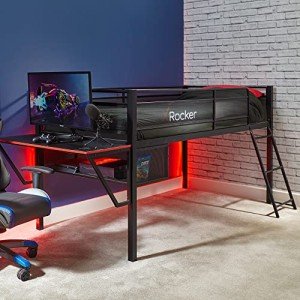This Is How Midsleeper Will Look In 10 Years Time
The Midsleeper: A Practical Solution for Kids' Bedrooms
When it comes to making the most of space in a child's bed room, the midsleeper bed stands apart as an innovative and functional solution. Combining the elevated structure of a loft bed with the accessibility of a standard bed, midsleepers use a special balance of play, storage, and sleeping services. This post will explore the features, advantages, and factors to consider of midsleeper beds, providing parents a comprehensive guide to understanding this functional furniture piece.
What is a Midsleeper Bed?
Midsleeper beds rise beds that typically have a sleeping area raised off the ground, however not as high as a conventional loft bed. This permits for an area beneath that can be utilized for different functions— whether it's for storage, a play location, or a research study spot. Midsleepers normally cater to kids and are created with safety and performance in mind.
Key Features of Midsleeper Beds
Height: Midsleepers are generally in between 1.2 to 1.5 meters high, making them accessible for children while ensuring they are safe.
Under-bed Space: The area listed below the bed is typically made use of for extra furniture or activities, consisting of desks, closets, or play areas.
Security Features: Most midsleepers come geared up with guardrails and ladders that adhere to security requirements, supplying comfort for moms and dads.
Design and Customization: Available in various styles, colors, and designs, midsleepers can be customized to fit any decoration, making them a flexible choice in kids's furniture.
Storage Solutions: Many midsleepers include integrated storage options, such as drawers or shelves, to assist keep the bed room organized.
Benefits of Choosing a Midsleeper Bed
Midsleepers offer numerous advantages that make them a popular choice for kids's bed rooms:
Space Efficiency
With the space-saving design of midsleepers, households can utilize the under-bed location for numerous purposes. This can assist keep the floor without clutter and develop a more orderly environment.
Motivation of Play and Creativity
The under-bed space motivates children to utilize their creativity. They can create a play zone, including camping tents, slides, or even a tiny castle, which promotes interactive play while making sure the room remains neat.
Adaptability and Longevity
Midsleepers deal with children as they grow, allowing for a transition from a play location to a research study zone. The added versatility suggests that these beds can adjust to the altering needs of a kid from toddlerhood to early teenage years.
Visual Appeal
With various designs readily available, midsleepers can improve the overall aesthetic of a space. Moms and dads can choose designs that match existing furniture or produce a whimsical environment that triggers a child's imagination.
Factors to consider When Choosing a Midsleeper
In spite of their various advantages, there are vital elements for moms and dads to consider when choosing a midsleeper:
Room Size: Measure the offered area in the bedroom to ensure it can accommodate a midsleeper without making the room feel cramped.
Age and Size of the Child: Ensure that the height of the bed appropriates for your child's age and size. Many midsleepers are safe for kids aged 6 and older due to their height.
Safety Standards: Check for safety accreditations, ensuring the midsleeper abides by local regulations concerning children's furnishings.
Gain access to and Mobility: Consider how quickly your child can access the bed. Ladders or stairs must be tough and firmly connected to promote ease of usage while also not being a tripping hazard.
Design and Storage Needs: Assess your kid's choices and the needed storage space. Select a midsleeper that complements the interior decoration of the space while fulfilling storage requirements.
Table: Key Differences Between Various Bed Types
Feature
Midsleeper
Loft Bed
Bunk Bed
Standard Bed
Height
Medium (1.2 – 1.5 m)
High (above 1.5 m)
Two beds stacked together
Low (generally ground level)
Under-bed Space
Yes
Yes
Yes (only one bed area)
No
Suggested Age
6+
8+
6+
2+
Safety Features
Guardrails, sturdy ladder
Guardrails, strong ladder
Guardrails
None
Space Efficiency
High
Very High
Moderate
Low
Frequently Asked Questions About Midsleeper Beds
1. What age is ideal for a midsleeper bed?
Midsleeper beds are normally recommended for kids aged 6 and older, ensuring they can securely browse the height and structure of the bed.
2. Do midsleeper beds need special bed mattress?
Midsleeper beds normally use basic single or twin bed mattress, but it is important to inspect the producer's standards for specific suggestions relating to density or size.
3. How can I guarantee my child is safe in a midsleeper?
To promote security, ensure that the bed is set up properly, acquaint your kid with using the ladder, and examine that guardrails are installed and safe.
4. Can I personalize a midsleeper bed?
Yes! Numerous midsleepers can be found in numerous designs and can be customized with devices such as tents, slides, and storage services to match your kid's preferences.
5. Are midsleepers simple to assemble?
Most midsleeper beds come with simple assembly directions, enabling moms and dads to set them up without professional aid. Nevertheless, it's advisable to have an extra pair of hands to assist.
Midsleeper beds present an outstanding solution for households seeking to enhance space in kids's spaces while offering a safe and fun sleeping plan. With their versatile designs, safety features, and myriad choices for customization, they deal with the requirements of growing children and adapt as those needs alter. By thoroughly thinking about factors such as space size, security requirements, and visual choices, parents can pick the ideal midsleeper to improve company and encourage imagination in their kid's bedroom.
